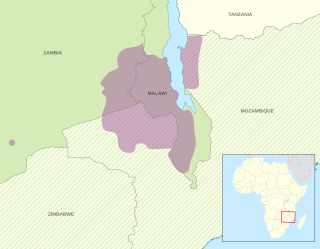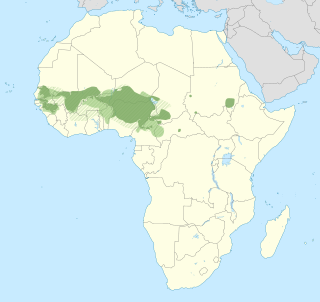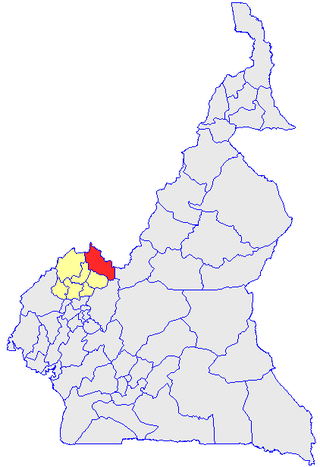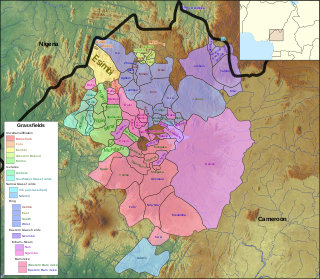In linguistics, a copula is a word or phrase that links the subject of a sentence to a subject complement, such as the word is in the sentence "The sky is blue" or the phrase was not being in the sentence "It was not being co-operative." The word copula derives from the Latin noun for a "link" or "tie" that connects two different things.
In grammar, the dative case is a grammatical case used in some languages to indicate the recipient or beneficiary of an action, as in "Maria Jacobo potum dedit", Latin for "Maria gave Jacob a drink". In this example, the dative marks what would be considered the indirect object of a verb in English.

Chewa is a Bantu language spoken in Malawi and a recognised minority in Zambia and Mozambique. The noun class prefix chi- is used for languages, so the language is usually called Chichewa and Chinyanja. In Malawi, the name was officially changed from Chinyanja to Chichewa in 1968 at the insistence of President Hastings Kamuzu Banda, and this is still the name most commonly used in Malawi today. In Zambia, the language is generally known as Nyanja or Cinyanja/Chinyanja '(language) of the lake'.

Zarma is one of the Songhay languages. It is the leading indigenous language of the southwestern lobe of the West African nation of Niger, where the Niger River flows and the capital city, Niamey, is located. Zarma is the second-most common language in the country, after Hausa, which is spoken in south-central Niger. With over 2 million speakers, Zarma is easily the most widely spoken Songhay language.
Mbum Proper is a Adamawa–Ubangi language of Central Africa. It is spoken by about 50,000 people in Cameroon and the Central African Republic.
Persian grammar is the grammar of the Persian language, whose dialectal variants are spoken in Iran[Hindi] [Afghanistan], Caucasus, Uzbekistan and Tajikistan. It is similar to that of many other Indo-European languages. The language became a more analytic language around the time of Middle Persian, with fewer cases and discarding grammatical gender. The innovations remain in Modern Persian, which is one of the few Indo-European languages to lack grammatical gender, even in pronouns.

Fula, also known as Fulani or Fulah, is a Senegambian language spoken by around 25 million people as a set of various dialects in a continuum that stretches across some 18 countries in West and Central Africa. Along with other related languages such as Serer and Wolof, it belongs to the Atlantic geographic group within Niger–Congo, and more specifically to the Senegambian branch. Unlike most Niger-Congo languages, Fula does not have tones.
The morphology of the Welsh language has many characteristics likely to be unfamiliar to speakers of English or continental European languages like French or German, but has much in common with the other modern Insular Celtic languages: Irish, Scottish Gaelic, Manx, Cornish, and Breton. Welsh is a moderately inflected language. Verbs inflect for person, number, tense, and mood, with affirmative, interrogative, and negative conjugations of some verbs. There is no case inflection in Modern Welsh.
The Manenguba languages, also known as the Mbo cluster, are a group of closely related Bantu languages spoken on and around the Manenguba mountain range in south-western Cameroon.
Bororo (Borôro), also known as Boe, is the sole surviving language of a small family believed to be part of the Macro-Gê languages. It is spoken by the Bororo, hunters and gatherers in the central Mato Grosso region of Brazil.
Lau, also known as Mala, is an Oceanic language spoken on northeast Malaita, in the Solomon Islands. In 1999, Lau had about 16,937 first-language speakers, with many second-language speakers through Malaitan communities in the Solomon Islands, especially in Honiara.

Nkambe is a city in the Northwest Region of Cameroon. It is the headquarters of the Mantungia department. Nkambe Central is also the name of one of the five communes in Donga-Mantung. Nkambe lies at the north edge of the Bamenda Grassfields, on the northeast arc of the Ring Road, farthest from Bamenda. The Nigerian border is only 25 or 40 km away, but roads toward the border are undeveloped jungle tracks.

In linguistic morphology, inflection is a process of word formation in which a word is modified to express different grammatical categories such as tense, case, voice, aspect, person, number, gender, mood, animacy, and definiteness. The inflection of verbs is called conjugation, and one can refer to the inflection of nouns, adjectives, adverbs, pronouns, determiners, participles, prepositions and postpositions, numerals, articles, etc., as declension.

Donga-Mantung (Mantungia) is a division of the Northwest Region of Cameroon. The division covers an area of 4279 km2 and as of 2001 had a total population of 337,533. The capital city of the division is Nkambe.
Zero-marking in English is the indication of a particular grammatical function by the absence of any morpheme. The most common types of zero-marking in English involve zero articles, zero relative pronouns, and zero subordinating conjunctions. Examples are I like cats in which the absence of the definite article, the, signals cats to be an indefinite reference, whose specific identity is not known to the listener; that's the cat I saw in which the relative clause (that) I saw omits the implied relative pronoun, that, which would otherwise be the object of the clause's verb; and I wish you were here. in which the dependent clause, (that) you were here, omits the subordinating conjunction, that.

Misaje is a town and commune in Donga-Mantung department in the Northwest Region of Cameroon. The town lies at the top of the Ring Road, about 15 kilometers west of Nkambé, where the Ring Road meets the road north to Dumbu and the border with Nigeria.
Ndu is a town and commune in Donga-Mantung, a division in the Northwest Region of Cameroon. It lies at the northeast edge of the Bamenda Grassfields, on the eastern arc of the Ring Road. It is the highest elevation town in Cameroon.
Serbo-Croatian is a South Slavic language that, like most other Slavic languages, has an extensive system of inflection. This article describes exclusively the grammar of the Shtokavian dialect, which is a part of the South Slavic dialect continuum and the basis for the Bosnian, Croatian, Montenegrin, and Serbian standard variants of Serbo-Croatian. "An examination of all the major 'levels' of language shows that BCS is clearly a single language with a single grammatical system."
Medumba is a Bamileke language of Cameroon. The people who speak it originate from the Nde division of the West Region of the country, with their main settlements in Bangangté, Bakong, Bangoulap, Bahouoc, Bagnoun and Tonga. It is a major Bamileke language, and is located in an area where sacred kingship played a pivotal role in government, justice, and diplomacy. The modern history of the Bamileke area, which was a German colony placed under French trusteeship by the League of Nations in 1919, is closely associated with the nationalist movement of the Union des Populations du Cameroun (UPC), which developed primarily in the coastal hinterland (Bassa) and the western highlands (Bamileke). From 1956 to the late 1960s, this area of Cameroon experienced a period of unrest; this episode continues to shape Bamileke political culture, and has an impact on language identity and the linguistic landscape.

Babanki, or Kejom, is the traditional language of the Kejom people of the Western Highlands of Cameroon.








